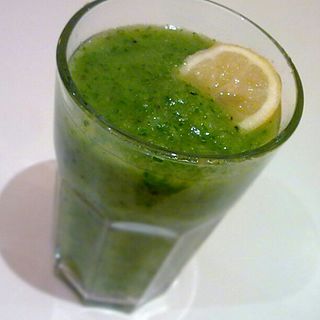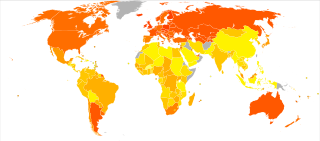Related Research Articles
Dieting is the practice of eating food in a regulated way to decrease, maintain, or increase body weight, or to prevent and treat diseases such as diabetes and obesity. As weight loss depends on calorie intake, different kinds of calorie-reduced diets, such as those emphasising particular macronutrients, have been shown to be no more effective than one another. As weight regain is common, diet success is best predicted by long-term adherence. Regardless, the outcome of a diet can vary widely depending on the individual.

Weight loss, in the context of medicine, health, or physical fitness, refers to a reduction of the total body mass, by a mean loss of fluid, body fat, or lean mass. Weight loss can either occur unintentionally because of malnourishment or an underlying disease, or from a conscious effort to improve an actual or perceived overweight or obese state. "Unexplained" weight loss that is not caused by reduction in calorific intake or increase in exercise is called cachexia and may be a symptom of a serious medical condition.

A fad diet is a diet that is popular, generally only for a short time, similar to fads in fashion, without being a standard scientific dietary recommendation, and often making unreasonable claims for fast weight loss or health improvements; as such is often considered a type of pseudoscientific diet. Fad diets are usually not supported by clinical research and their health recommendations are not peer-reviewed, thus they often make unsubstantiated statements about health and disease.

Low-carbohydrate diets restrict carbohydrate consumption relative to the average diet. Foods high in carbohydrates are limited, and replaced with foods containing a higher percentage of fat and protein, as well as low carbohydrate foods.

The Okinawa diet describes the traditional dietary practices of indigenous people of the Ryukyu Islands, which were claimed to have contributed to their relative longevity over a period of study in the 20th century.
A low-protein diet is a diet in which people decrease their intake of protein. A low-protein diet is used as a therapy for inherited metabolic disorders, such as phenylketonuria and homocystinuria, and can also be used to treat kidney or liver disease. Low protein consumption appears to reduce the risk of bone breakage, presumably through changes in calcium homeostasis. Consequently, there is no uniform definition of what constitutes low-protein, because the amount and composition of protein for an individual with phenylketonuria would differ substantially from one with homocystinuria or tyrosinemia.

A healthy diet is a diet that maintains or improves overall health. A healthy diet provides the body with essential nutrition: fluid, macronutrients such as protein, micronutrients such as vitamins, and adequate fibre and food energy.

Protein–energy undernutrition (PEU), once called protein-energy malnutrition (PEM), is a form of malnutrition that is defined as a range of conditions arising from coincident lack of dietary protein and/or energy (calories) in varying proportions. The condition has mild, moderate, and severe degrees.

A very-low-calorie diet (VLCD), also known as semistarvation diet and crash diet, is a type of diet with very or extremely low daily food energy consumption. VLCDs are defined as a diet of 800 kilocalories (3,300 kJ) per day or less. Modern medically supervised VLCDs use total meal replacements, with regulated formulations in Europe and Canada which contain the recommended daily requirements for vitamins, minerals, trace elements, fatty acids, protein and electrolyte balance. Carbohydrates may be entirely absent, or substituted for a portion of the protein; this choice has important metabolic effects. Medically supervised VLCDs have specific therapeutic applications for rapid weight loss, such as in morbid obesity or before a bariatric surgery, using formulated, nutritionally complete liquid meals containing 800 kilocalories or less per day for a maximum of 12 weeks.
A diabetic diet is a diet that is used by people with diabetes mellitus or high blood sugar to minimize symptoms and dangerous complications of long-term elevations in blood sugar.
Leonard Pershing Guarente is an American biologist best known for his research on life span extension in the budding yeast Saccharomyces cerevisiae, roundworms, and mice. He is a Novartis Professor of Biology at the Massachusetts Institute of Technology.

The Western pattern diet is a modern dietary pattern that is generally characterized by high intakes of pre-packaged foods, refined grains, red meat, processed meat, high-sugar drinks, candy and sweets, fried foods, industrially produced animal products, butter and other high-fat dairy products, eggs, potatoes, corn, and low intakes of fruits, vegetables, whole grains, pasture-raised animal products, fish, nuts, and seeds.
Intermittent fasting is any of various meal timing schedules that cycle between voluntary fasting and non-fasting over a given period. Methods of intermittent fasting include alternate-day fasting, periodic fasting such as the 5:2 diet, and daily time-restricted eating (TRE).

Diet plays an important role in the genesis of obesity. Personal choices, food advertising, social customs and cultural influences, as well as food availability and pricing all play a role in determining what and how much an individual eats.
CALERIE is a trial currently underway in the U.S. to study the effects of prolonged calorie restriction on healthy human subjects.

Weight management refers to behaviors, techniques, and physiological processes that contribute to a person's ability to attain and maintain a healthy weight. Most weight management techniques encompass long-term lifestyle strategies that promote healthy eating and daily physical activity. Moreover, weight management involves developing meaningful ways to track weight over time and to identify ideal body weights for different individuals.
Management of obesity can include lifestyle changes, medications, or surgery. Although many studies have sought effective interventions, there is currently no evidence-based, well-defined, and efficient intervention to prevent obesity.

Added sugars or free sugars are sugar carbohydrates added to food and beverages at some point before their consumption. These include added carbohydrates, and more broadly, sugars naturally present in honey, syrup, fruit juices and fruit juice concentrates. They can take multiple chemical forms, including sucrose, glucose (dextrose), and fructose.

A sweetened beverage is any beverage with added sugar. It has been described as "liquid candy". Consumption of sweetened beverages has been linked to weight gain, obesity, and associated health risks. According to the CDC, consumption of sweetened beverages is also associated with unhealthy behaviors like smoking, not getting enough sleep and exercise, and eating fast food often and not enough fruits regularly.
The relationship between diet and longevity encompasses diverse research studies involving both humans and animals, requiring an analysis of complex mechanisms underlying the potential relationship between various dietary practices, health, and longevity.
References
- 1 2 3 4 5 6 7 8 9 Lee MB, Hill CM, Bitto A, Kaeberlein M (November 2021). "Antiaging diets: Separating fact from fiction". Science. 374 (6570): eabe7365. doi:10.1126/science.abe7365. PMC 8841109 . PMID 34793210.
- ↑ Flanagan EW, Most J, Mey JT, Redman LM (September 2020). "Calorie Restriction and Aging in Humans". Annual Review of Nutrition. 40: 105–133. doi:10.1146/annurev-nutr-122319-034601. PMC 9042193 . PMID 32559388.
- ↑ US Department of Health and Human Services. (2017). "2015–2020 Dietary Guidelines for Americans - health.gov". health.gov. Skyhorse Publishing Inc. Retrieved 30 September 2019.
- 1 2 Arnett DK, Blumenthal RS, Albert MA, Buroker AB, Goldberger ZD, Hahn EJ, et al. (September 2019). "2019 ACC/AHA Guideline on the Primary Prevention of Cardiovascular Disease: A Report of the American College of Cardiology/American Heart Association Task Force on Clinical Practice Guidelines". Circulation. 140 (11): e596–e646. doi: 10.1161/CIR.0000000000000678 . PMC 7734661 . PMID 30879355.
- ↑ "Obesity: maintaining a healthy weight and preventing excess weight gain". pathways.nice.org.uk.
- 1 2 Jensen MD, Ryan DH, Apovian CM, Ard JD, Comuzzie AG, Donato KA, et al. (June 2014). "2013 AHA/ACC/TOS guideline for the management of overweight and obesity in adults: a report of the American College of Cardiology/American Heart Association Task Force on Practice Guidelines and The Obesity Society". Circulation. 129 (25 Suppl 2): S102–S138. doi:10.1161/01.cir.0000437739.71477.ee. PMC 5819889 . PMID 24222017.
- ↑ "Diet - NICE Pathways". pathways.nice.org.uk.
- ↑ Garvey WT, Mechanick JI, Brett EM, Garber AJ, Hurley DL, Jastreboff AM, et al. (July 2016). "American Association of Clinical Endocrinologists and American College of Endocrinology Comprehensive Clinical Practice Guidelines for Medical Care of Patients with Obesity". Endocrine Practice. 22 (Suppl 3): 1–203. doi: 10.4158/EP161365.GL . PMID 27219496.
- ↑ American Diabetes Association (January 2019). "5. Lifestyle Management: Standards of Medical Care in Diabetes-2019". Diabetes Care. 42 (Suppl 1): S46–S60. doi: 10.2337/dc19-S005 . PMID 30559231.
- 1 2 3 Evert AB, Dennison M, Gardner CD, Garvey WT, Lau KH, MacLeod J, et al. (May 2019). "Nutrition Therapy for Adults With Diabetes or Prediabetes: A Consensus Report". Diabetes Care (Professional society guidelines). 42 (5): 731–754. doi: 10.2337/dci19-0014 . PMC 7011201 . PMID 31000505.
- ↑ Glazier JD, Hayes DJ, Hussain S, D'Souza SW, Whitcombe J, Heazell AE, Ashton N (October 2018). "The effect of Ramadan fasting during pregnancy on perinatal outcomes: a systematic review and meta-analysis". BMC Pregnancy and Childbirth. 18 (1): 421. doi: 10.1186/s12884-018-2048-y . PMC 6202808 . PMID 30359228.
- ↑ Thangaratinam S, Rogozinska E, Jolly K, Glinkowski S, Roseboom T, Tomlinson JW, et al. (May 2012). "Effects of interventions in pregnancy on maternal weight and obstetric outcomes: meta-analysis of randomised evidence". BMJ. 344: e2088. doi:10.1136/bmj.e2088. PMC 3355191 . PMID 22596383.
- 1 2 3 Keys A, Brozek J, Henschels A & Mickelsen O & Taylor H. The Biology of Human Starvation, 1950. University of Minnesota Press, Minneapolis
- ↑ Keys A 1950, p. 114.
- ↑ St Jeor ST, Howard BV, Prewitt TE, Bovee V, Bazzarre T, Eckel RH (October 2001). "Dietary protein and weight reduction: a statement for healthcare professionals from the Nutrition Committee of the Council on Nutrition, Physical Activity, and Metabolism of the American Heart Association". Circulation. 104 (15): 1869–1874. doi: 10.1161/hc4001.096152 . PMID 11591629.
- ↑ de Souza RJ, Swain JF, Appel LJ, Sacks FM (July 2008). "Alternatives for macronutrient intake and chronic disease: a comparison of the OmniHeart diets with popular diets and with dietary recommendations". The American Journal of Clinical Nutrition. 88 (1): 1–11. doi:10.1093/ajcn/88.1.1. PMC 2674146 . PMID 18614716.
- ↑ Ma Y, Pagoto SL, Griffith JA, Merriam PA, Ockene IS, Hafner AR, Olendzki BC (October 2007). "A dietary quality comparison of popular weight-loss plans". Journal of the American Dietetic Association. 107 (10): 1786–1791. doi:10.1016/j.jada.2007.07.013. PMC 2040023 . PMID 17904938.
- ↑ Marzetti E, Wohlgemuth SE, Anton SD, Bernabei R, Carter CS, Leeuwenburgh C (November 2009). "Cellular mechanisms of cardioprotection by calorie restriction: state of the science and future perspectives". Clinics in Geriatric Medicine. 25 (4): 715–32, ix. doi:10.1016/j.cger.2009.07.002. PMC 2786899 . PMID 19944269.
- 1 2 Dirks AJ, Leeuwenburgh C (January 2006). "Caloric restriction in humans: potential pitfalls and health concerns". Mechanisms of Ageing and Development. 127 (1): 1–7. doi:10.1016/j.mad.2005.09.001. PMID 16226298.
- ↑ Caristia S, Vito M, Sarro A, Leone A, Pecere A, Zibetti A, et al. (July 2020). "Is Caloric Restriction Associated with Better Healthy Aging Outcomes? A Systematic Review and Meta-Analysis of Randomized Controlled Trials". Nutrients. 12 (8): 2290. doi: 10.3390/nu12082290 . PMC 7468870 . PMID 32751664.
- ↑ O'Keefe JH, Torres-Acosta N, O'Keefe EL, Saeed IM, Lavie CJ, Smith SE, Ros E (September 2020). "A pesco-Mediterranean diet with intermittent fasting: JACC Review Topic of the Week". Journal of the American College of Cardiology. 76 (12): 1484–1493. doi: 10.1016/j.jacc.2020.07.049 . PMID 32943166. S2CID 221787788.
- 1 2 3 4 5 Most J, Tosti V, Redman LM, Fontana L (October 2017). "Calorie restriction in humans: An update". Ageing Research Reviews. Nutritional interventions modulating aging and age-associated diseases. 39: 36–45. doi:10.1016/j.arr.2016.08.005. PMC 5315691 . PMID 27544442.
- ↑ Keys A, Brožek J, Henschel A, Mickelsen O, Taylor HL (1950). The biology of human starvation (2 vols). Univ. of Minnesota Press.
- ↑ Marik PE, Hooper MH (March 2016). "Normocaloric versus hypocaloric feeding on the outcomes of ICU patients: a systematic review and meta-analysis". Intensive Care Medicine. 42 (3): 316–323. doi:10.1007/s00134-015-4131-4. PMID 26556615. S2CID 37653149.
- ↑ Bitzani M (April 2016). "Comments on Marik and Hooper: Normocaloric versus hypocaloric feeding on the outcomes of ICU patients: a systematic review and meta-analysis". Intensive Care Medicine. 42 (4): 628–629. doi:10.1007/s00134-016-4248-0. PMID 26880090. S2CID 34072936.
- 1 2 National Institutes of Health (2012-08-29). "NIH study finds calorie restriction does not affect survival" . Retrieved May 17, 2016.
- ↑ Nicholas Wade (April 1, 2014). "Diet's Link to Longevity: After 2 Studies Diverge, a Search for Consensus". The New York Times. Retrieved May 17, 2016.
- 1 2 3 Mattison JA, Colman RJ, Beasley TM, Allison DB, Kemnitz JW, Roth GS, et al. (January 2017). "Caloric restriction improves health and survival of rhesus monkeys". Nature Communications. 8 (1): 14063. Bibcode:2017NatCo...814063M. doi:10.1038/ncomms14063. PMC 5247583 . PMID 28094793.
- ↑ "Calorie restriction lets monkeys live long and prosper". ScienceDirect. 17 January 2017. Retrieved 15 February 2017.
- ↑ Mattison JA, Roth GS, Beasley TM, Tilmont EM, Handy AM, Herbert RL, et al. (September 2012). "Impact of caloric restriction on health and survival in rhesus monkeys from the NIA study". Nature. 489 (7415): 318–321. Bibcode:2012Natur.489..318M. doi:10.1038/nature11432. PMC 3832985 . PMID 22932268.
- ↑ Vaughan KL, Kaiser T, Peaden R, Anson RM, de Cabo R, Mattison JA (December 2017). "Caloric Restriction Study Design Limitations in Rodent and Nonhuman Primate Studies". The Journals of Gerontology. Series A, Biological Sciences and Medical Sciences. 73 (1): 48–53. doi:10.1093/gerona/glx088. PMC 5861872 . PMID 28977341.
- ↑ McKiernan SH, Colman RJ, Aiken E, Evans TD, Beasley TM, Aiken JM, et al. (March 2012). "Cellular adaptation contributes to calorie restriction-induced preservation of skeletal muscle in aged rhesus monkeys". Experimental Gerontology. 47 (3): 229–236. doi:10.1016/j.exger.2011.12.009. PMC 3321729 . PMID 22226624.
- ↑ Colman RJ, Beasley TM, Allison DB, Weindruch R (June 2008). "Attenuation of sarcopenia by dietary restriction in rhesus monkeys". The Journals of Gerontology. Series A, Biological Sciences and Medical Sciences. 63 (6): 556–559. doi:10.1093/gerona/63.6.556. PMC 2812805 . PMID 18559628.
- ↑ Dirks Naylor AJ, Leeuwenburgh C (January 2008). "Sarcopenia: the role of apoptosis and modulation by caloric restriction". Exercise and Sport Sciences Reviews. 36 (1): 19–24. doi: 10.1097/jes.0b013e31815ddd9d . PMID 18156949. S2CID 4596744. Archived from the original on 2021-12-02.
- ↑ Faulks SC, Turner N, Else PL, Hulbert AJ (August 2006). "Calorie restriction in mice: effects on body composition, daily activity, metabolic rate, mitochondrial reactive oxygen species production, and membrane fatty acid composition". The Journals of Gerontology. Series A, Biological Sciences and Medical Sciences. 61 (8): 781–794. doi: 10.1093/gerona/61.8.781 . PMID 16912094.
- ↑ Chang HC, Guarente L (March 2014). "SIRT1 and other sirtuins in metabolism". Trends in Endocrinology and Metabolism. 25 (3): 138–145. doi:10.1016/j.tem.2013.12.001. hdl:1721.1/104067. PMC 3943707 . PMID 24388149.
- 1 2 Guarente L (2007). "Sirtuins in aging and disease". Cold Spring Harbor Symposia on Quantitative Biology. 72: 483–488. doi: 10.1101/sqb.2007.72.024 . PMID 18419308.
- ↑ Lin SJ, Ford E, Haigis M, Liszt G, Guarente L (January 2004). "Calorie restriction extends yeast life span by lowering the level of NADH". Genes & Development. 18 (1): 12–16. doi:10.1101/gad.1164804. PMC 314267 . PMID 14724176.
- ↑ Kaeberlein M, McVey M, Guarente L (October 1999). "The SIR2/3/4 complex and SIR2 alone promote longevity in Saccharomyces cerevisiae by two different mechanisms". Genes & Development. 13 (19): 2570–2580. doi:10.1101/gad.13.19.2570. PMC 317077 . PMID 10521401.